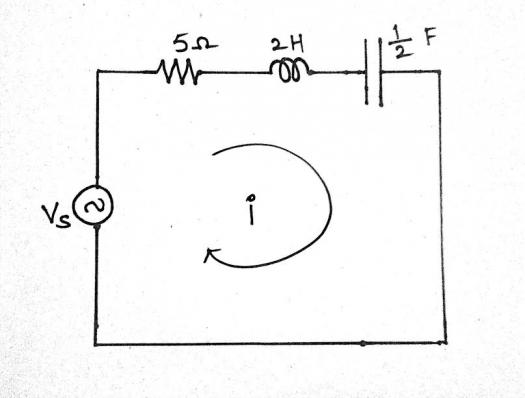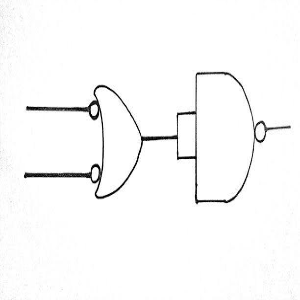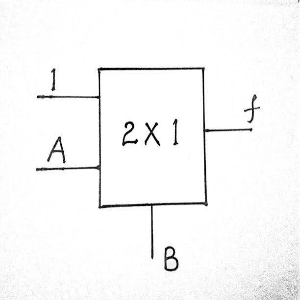Trishna - The Technical Quiz

- 1.
Which mode of operation is preferred to work BJT as an attenuator ?
- A.
Saturation
- B.
Reverse active
- C.
Cut off
- D.
Active
Correct Answer
B. Reverse activeExplanation
Reverse active mode is preferred to work BJT as an attenuator because in this mode, the BJT operates with the collector-base junction reverse biased and the emitter-base junction forward biased. This configuration allows for a high input impedance and low output impedance, making it suitable for attenuating signals. Additionally, the reverse active mode provides a high voltage gain, which is desirable for attenuating high-frequency signals.Rate this question:
-
- 2.
What is the r.m.s. value of output voltage for an half wave rectifier ,if input V(max)=2 volts ?
- A.
1.414
- B.
1
- C.
2
- D.
2.828
Correct Answer
B. 1Explanation
The r.m.s. value of the output voltage for a half wave rectifier can be calculated by dividing the maximum voltage by the square root of 2. In this case, the input V(max) is given as 2 volts. Therefore, the r.m.s. value of the output voltage would be 1 volt.Rate this question:
-
- 3.
What is the effect of negative feedback ?
- A.
Increase in noice
- B.
Decrease in bandwidth
- C.
Decrease in gain
- D.
Both b & c
Correct Answer
C. Decrease in gainExplanation
Negative feedback has the effect of reducing the gain of a system. This is because the feedback signal is subtracted from the input signal, resulting in a smaller overall output. By reducing the gain, negative feedback helps to stabilize the system and reduce distortion or oscillation. Therefore, the correct answer is "Decrease in gain".Rate this question:
-
- 4.
𝛿(-2t)=
- A.
-𝛿(t)/2
- B.
-2𝛿(t)
- C.
𝛿(t)/2
- D.
2𝛿(t)
Correct Answer
C. 𝛿(t)/2Explanation
The given equation states that the Dirac delta function (-2t) is equal to (-𝛿(t)/2). This means that the Dirac delta function (-2t) is equal to half of the negative Dirac delta function (-𝛿(t)/2).Rate this question:
-
- 5.
Bandwidth of DSB-SC signal if maximum frequency component of input message signal 4KHz?
- A.
4KHz
- B.
8KHz
- C.
6KHz
- D.
2KHz
Correct Answer
B. 8KHzExplanation
The bandwidth of a DSB-SC (Double Sideband Suppressed Carrier) signal is twice the maximum frequency component of the input message signal. In this case, the maximum frequency component of the input message signal is 4KHz. Therefore, the bandwidth of the DSB-SC signal would be 8KHz.Rate this question:
-
- 6.
What is the value of Rs for which maximum power is transferred to RL?
- A.
5 Ω
- B.
10 Ω
- C.
0 Ω
- D.
∞ Ω
Correct Answer
C. 0 ΩExplanation
When the value of RL is 0 Ω, it means that the load resistance is completely absent or disconnected. In this case, the maximum power will be transferred to RL because there is no resistance to impede the flow of current. As a result, the entire voltage will be across the load, maximizing the power transfer. Therefore, the value of Rs for which maximum power is transferred to RL is 0 Ω.Rate this question:
-
- 7.
Condition for symmetic network ?
- A.
Y<sub style="color: rgb(93, 93, 93); font-family: Roboto, sans-serif;">12 = - Y21
- B.
AD - BC = 1
- C.
Z11 = Z22
- D.
H12 = - h21
Correct Answer
C. Z11 = Z22Explanation
The condition for a symmetric network is that the impedance at port 1 (Z11) is equal to the impedance at port 2 (Z22). This means that the network behaves the same way when signals are applied to either port.Rate this question:
-
- 8.
Any series RLC network represents__________?
- A.
High pass filter
- B.
Low pass filter
- C.
Band pass filter
- D.
Band reject filter
Correct Answer
C. Band pass filterExplanation
A series RLC network consists of a resistor, inductor, and capacitor connected in series. This configuration allows only a specific range of frequencies to pass through, while attenuating frequencies outside of this range. Therefore, a series RLC network represents a band pass filter, which allows a band of frequencies to pass through and rejects frequencies outside of this band.Rate this question:
-
- 9.
The value of frequency at which maximum current flows in the circuit is______
- A.
1
- B.
1/2
- C.
1/4π
- D.
1/2π
Correct Answer
D. 1/2πExplanation
The value of frequency at which maximum current flows in the circuit is 1/2π. This is because in an AC circuit, the current and voltage are related by the impedance, which is a complex quantity. The impedance has both a magnitude and a phase angle. At the frequency of 1/2π, the impedance is purely real, meaning it has no imaginary component. This results in the maximum current flowing in the circuit.Rate this question:
-
- 10.
Transfer function of a system is
- A.
L.T of impulse response
- B.
L.T of unit step response
- C.
Ratio of L.T of output and L.T of input
- D.
Both '1' and '3'
Correct Answer
D. Both '1' and '3'Explanation
The transfer function of a system can be obtained by taking the Laplace Transform of the impulse response or by taking the ratio of the Laplace Transform of the output to the Laplace Transform of the input. Therefore, the correct answer is both option 1 and option 3.Rate this question:
-
- 11.
Curl of vector is always
- A.
Irrotational
- B.
Solenoidal
- C.
Both
- D.
None
Correct Answer
B. SolenoidalExplanation
The curl of a vector measures the rotation or circulation of the vector field. If the curl is zero, it indicates that the vector field is irrotational, meaning there is no rotation or circulation. On the other hand, if the curl is not zero, it suggests that the vector field is solenoidal, indicating the presence of rotation or circulation. Therefore, the correct answer is solenoidal, as the curl of a vector is not always zero, implying that the vector field can have rotation or circulation.Rate this question:
-
- 12.
Convert Binary code (1011)2 to Grey code ?
- A.
1111
- B.
0101
- C.
1110
- D.
1101
Correct Answer
C. 1110Explanation
To convert a binary code to Grey code, we need to apply the Grey code conversion rule which states that each bit in the Grey code is obtained by XORing the corresponding bits in the binary code. In this case, the binary code is 1011. To obtain the Grey code, we XOR the first bit with the second bit, the second bit with the third bit, and the third bit with the fourth bit. This gives us the Grey code 1110, which matches the given answer.Rate this question:
-
- 13.
Bandwidth of a given circuit is
- A.
4 Hz
- B.
2 Hz
- C.
6 Hz
- D.
8 Hz
Correct Answer
B. 2 HzExplanation
The bandwidth of a given circuit refers to the range of frequencies that the circuit can effectively transmit. In this case, the correct answer is 2 Hz, which means that the circuit is capable of transmitting frequencies up to 2 Hz. This implies that the circuit has a limited capacity to transmit higher frequency signals, making it suitable for applications that require a narrow range of frequencies.Rate this question:
-
- 14.
Given figure is equivalent to ?
- A.
NAND
- B.
OR
- C.
NOR
- D.
AND
Correct Answer
D. ANDExplanation
The given figure represents the AND gate. In an AND gate, the output is only high (1) when both inputs are high (1). If any of the inputs is low (0), the output will be low (0). This is indicated by the connection of the inputs to the small circles, which represent the logical operation of AND. Therefore, the correct answer is AND.Rate this question:
-
- 15.
The output expression 'f' is
- A.
AB
- B.
A'+B
- C.
A+B
- D.
A+B'
Correct Answer
D. A+B'Explanation
The output expression 'f' is equal to A+B'. This means that the output 'f' is the result of performing the logical OR operation between inputs A and B, and then negating the result. In other words, if either A or B is true, 'f' will be false. If both A and B are false, 'f' will be true.Rate this question:
-
- 16.
Number of NAND gates required for expression A'B+AB' ?
- A.
5
- B.
3
- C.
4
- D.
6
Correct Answer
C. 4Explanation
The expression A'B + AB' can be simplified using De Morgan's theorem as (A + B')(A' + B). This can be further simplified using distributive law as AA' + AB + A'B + BB', which simplifies to AB + A'B. This expression can be implemented using 4 NAND gates. Hence, the correct answer is 4.Rate this question:
-
- 17.
The frequency of output waveform if propagation delay of each gate is 1/6 ns
- A.
1MHz
- B.
10GHz
- C.
1GHz
- D.
100MHz
Correct Answer
C. 1GHzExplanation
The frequency of the output waveform is determined by the propagation delay of each gate. In this case, the propagation delay is given as 1/6 ns. Since frequency is the reciprocal of the period, we can calculate the frequency by taking the reciprocal of the propagation delay. Therefore, the frequency is 1 / (1/6 ns) = 6 GHz. However, since the options given are in MHz and GHz, we convert 6 GHz to 6000 MHz. Therefore, the correct answer is 1 GHz.Rate this question:
-
- 18.
RMS value of ( 5 + 2cos2t + 3sin2t ) =
Correct Answer
5.612,5.6,5.61Explanation
The RMS value of a periodic function is the square root of the average of the square of the function over one period. In this case, the given function is a sum of a constant term (5), a cosine term (2cos2t), and a sine term (3sin2t). The RMS value can be found by squaring each term, taking the average, and then taking the square root. Since the constant term does not change with time, its square does not affect the average. The square of the cosine and sine terms will have an average value of 1/2, as they oscillate between -1 and 1 over one period. Therefore, the RMS value is sqrt(5^2 + (2^2 + 3^2)/2) = sqrt(25 + 13/2) = sqrt(63/2) ≈ 5.612.Rate this question:
- 19.
Internal resistance of Ideal voltage source is
Correct Answer
zero,0Explanation
The internal resistance of an ideal voltage source is zero because an ideal voltage source is a theoretical concept that provides a constant voltage regardless of the load connected to it. In practical terms, this means that the voltage source can deliver any amount of current without a drop in voltage. Therefore, there is no internal resistance in an ideal voltage source, resulting in a value of zero.Rate this question:
- 20.
Conductivity of pure seiconductor at '0'K is
Correct Answer
zero,0Explanation
At absolute zero temperature (0 K), the conductivity of a pure semiconductor becomes zero. This is because at this extremely low temperature, all the electrons in the valence band of the semiconductor are in their lowest energy state and tightly bound to their atoms. As a result, there are no free electrons available for conduction, leading to zero conductivity.Rate this question:
Quiz Review Timeline +
Our quizzes are rigorously reviewed, monitored and continuously updated by our expert board to maintain accuracy, relevance, and timeliness.
-
Current Version
-
Mar 22, 2023Quiz Edited by
ProProfs Editorial Team -
Feb 27, 2017Quiz Created by
Trishna1
- Aeronautics Quizzes
- Aerospace Quizzes
- Agricultural Science Quizzes
- Astrology Quizzes
- Astronomy Quizzes
- Atom Quizzes
- Biochemistry Quizzes
- Biology Quizzes
- Biomechanics Quizzes
- Biostatistics Quizzes
- Biotechnology Quizzes
- Botany Quizzes
- Branches Of Science Quizzes
- Chemistry Quizzes
- Cytology Quizzes
- Easy Science Quizzes
- Ecology Quizzes
- Electrical Quizzes
- Embryology Quizzes
- Endocrinology Quizzes
- Engineering Quizzes
- Environmental Science Quizzes
- Epidemiology Quizzes
- Forestry Quizzes
- Fossil Quizzes
- Gas Quizzes
- General Science Quizzes
- Genetics Quizzes
- Histology Quizzes
- Human Biology Quizzes
- Integrated Science Quizzes
- Invention Quizzes
- Library Science Quizzes
- Lighting Quizzes
- Liquid Quizzes
- Marine Biology Quizzes
- Microbiology Quizzes
- Molecular Biology Quizzes
- Nature Quizzes
- Neuroscience Quizzes
- Nuclear Science Quizzes
- Oceanography Quizzes
- Physics Quizzes
- Psychology Quizzes
- Science And Technology Quizzes
- Science Glossary Quizzes
- Science Knowledge Quizzes
- Science Practice Quizzes
- Scientific Notation Quizzes
- Soil Science Quizzes
- Solar System Quizzes
- Solid Quizzes
- Zoology Quizzes
 Back to top
Back to top








